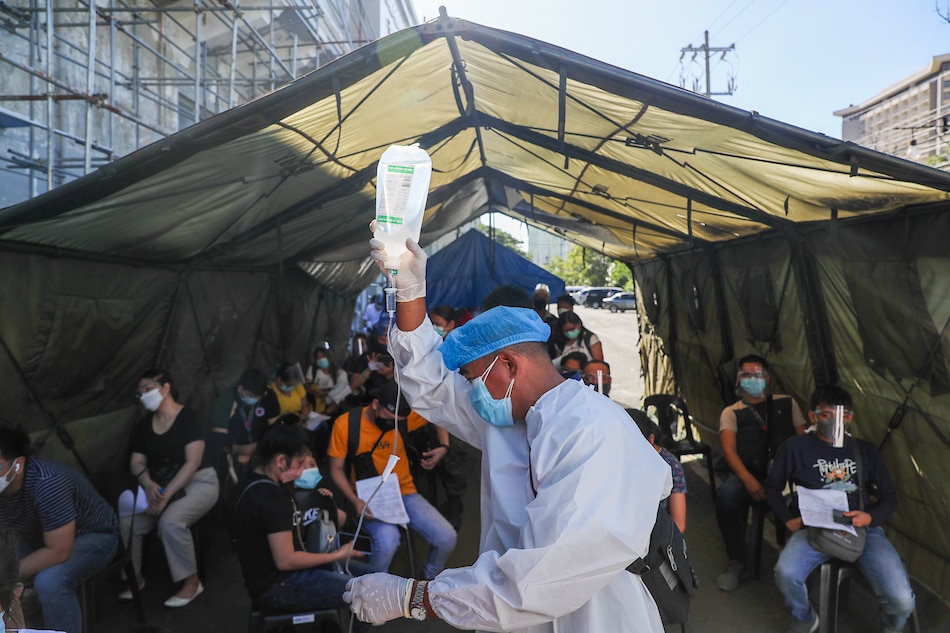Philippines may log 20,000 COVID-19 cases daily by next week: OCTA | ABS-CBN
ADVERTISEMENT

Welcome, Kapamilya! We use cookies to improve your browsing experience. Continuing to use this site means you agree to our use of cookies. Tell me more!
Philippines may log 20,000 COVID-19 cases daily by next week: OCTA
Philippines may log 20,000 COVID-19 cases daily by next week: OCTA
Jamaine Punzalan,
ABS-CBN News
Published Jan 05, 2022 02:40 PM PHT
|
Updated Jan 05, 2022 04:03 PM PHT
MANILA — The Philippines might report around 20,000 new COVID-19 cases daily next week, the OCTA research group warned on Wednesday, as authorities tried to limit cases of the omicron variant spreading globally.
MANILA — The Philippines might report around 20,000 new COVID-19 cases daily next week, the OCTA research group warned on Wednesday, as authorities tried to limit cases of the omicron variant spreading globally.
The country on Tuesday logged 5,434 fresh COVID-19 cases and a positivity rate of 26.2 percent, the highest since Sep. 15 last year.
The country on Tuesday logged 5,434 fresh COVID-19 cases and a positivity rate of 26.2 percent, the highest since Sep. 15 last year.
Wednesday's tally of new infections is projected to hit 11,000 to 12,000, with Metro Manila registering around 8,000, said OCTA fellow Guido David.
Wednesday's tally of new infections is projected to hit 11,000 to 12,000, with Metro Manila registering around 8,000, said OCTA fellow Guido David.
“By next week, most likely madadagdagan pa ‘yan. Posibleng dumoble pa ‘yan, aabot tayo mga 20,000 plus,” David said in a televised public briefing.
“By next week, most likely madadagdagan pa ‘yan. Posibleng dumoble pa ‘yan, aabot tayo mga 20,000 plus,” David said in a televised public briefing.
ADVERTISEMENT
“Kung susundan natin iyong South Africa experience at dahil marami na tayong bakunado, may chance na pagdating ng kalagitnaan ng January, doon na natin makikita iyong peak at magsisimula nang bumaba,” he added.
“Kung susundan natin iyong South Africa experience at dahil marami na tayong bakunado, may chance na pagdating ng kalagitnaan ng January, doon na natin makikita iyong peak at magsisimula nang bumaba,” he added.
(By next week, that will likely increase further. That could double, and we might reach 20,000 plus. If we follow the South Africa experience, and because many are already vaccinated, there is a chance that we will see the peak by mid-January and cases will start to go down.)
(By next week, that will likely increase further. That could double, and we might reach 20,000 plus. If we follow the South Africa experience, and because many are already vaccinated, there is a chance that we will see the peak by mid-January and cases will start to go down.)
The Department of Health is projecting that the new wave of rising COVID-19 cases observed now in the country will peak by the end of the month, its spokesperson said Wednesday.
The Department of Health is projecting that the new wave of rising COVID-19 cases observed now in the country will peak by the end of the month, its spokesperson said Wednesday.
The Philippines has detected at least 14 cases of the omicron variant of concern. Its capacity for genome sequencing is limited.
The Philippines has detected at least 14 cases of the omicron variant of concern. Its capacity for genome sequencing is limited.
David said Metro Manila's COVID-19 reproduction rate was at 5, meaning one patient can infect up to 5 people.
David said Metro Manila's COVID-19 reproduction rate was at 5, meaning one patient can infect up to 5 people.
ADVERTISEMENT
The region's 7-day positivity rate or the percent of COVID-19 tests that come back as positive was 25. But Metro Manila's positivity rate on Tuesday was at 40 percent, he said.
The region's 7-day positivity rate or the percent of COVID-19 tests that come back as positive was 25. But Metro Manila's positivity rate on Tuesday was at 40 percent, he said.
Despite these figures, David noted the capital region's 34-percent healthcare utilization was still far from the 70-percent critical threshold.
Despite these figures, David noted the capital region's 34-percent healthcare utilization was still far from the 70-percent critical threshold.
Home to some 13.5 million people, Metro Manila was upgraded to COVID-19 Alert Level 3 on Monday until Jan. 15.
Home to some 13.5 million people, Metro Manila was upgraded to COVID-19 Alert Level 3 on Monday until Jan. 15.
It typically takes 2 to 3 days before the effect of alert level shifts could be felt, said David, a mathematics professor at the University of the Philippines.
It typically takes 2 to 3 days before the effect of alert level shifts could be felt, said David, a mathematics professor at the University of the Philippines.
He also noted that Metro Manila imposed additional mobility restrictions on unvaccinated people. “Sa tingin natin, makakatulong ito,” he said.
He also noted that Metro Manila imposed additional mobility restrictions on unvaccinated people. “Sa tingin natin, makakatulong ito,” he said.
ADVERTISEMENT
(We think this could help.)
(We think this could help.)
David said the surge in infections in South Africa, the first country to detect the omicron variant in November, lasted for a month.
David said the surge in infections in South Africa, the first country to detect the omicron variant in November, lasted for a month.
“Iyan ang inaasahan nating best case scenario. Pero hindi pa natin mapapangako na ganiyan ang mangyayari sa atin sa NCR,” he said.
“Iyan ang inaasahan nating best case scenario. Pero hindi pa natin mapapangako na ganiyan ang mangyayari sa atin sa NCR,” he said.
(That is the best case scenario we are expecting. But we cannot promise yet that this is what will happen with us in NCR.)
(That is the best case scenario we are expecting. But we cannot promise yet that this is what will happen with us in NCR.)
He appealed to the public, “Kailangan natin magtulungan, gawin natin iyong parte natin. Sumunod tayo sa public health standards.”
He appealed to the public, “Kailangan natin magtulungan, gawin natin iyong parte natin. Sumunod tayo sa public health standards.”
ADVERTISEMENT
(We need to help each other and do our part. Let us follow public health standards.)
(We need to help each other and do our part. Let us follow public health standards.)
Lawmakers have criticized OCTA Research for the accuracy of its COVID-19 projections. The group said it uses data from the DOH.
Lawmakers have criticized OCTA Research for the accuracy of its COVID-19 projections. The group said it uses data from the DOH.
The country's total recorded COVID-19 cases stood at 2,861,119, as of Tuesday, of which, 29,809 are active. Of those still battling the disease, 328 are in critical condition, 1,546 are severely ill, and 3,020 are moderate.
The country's total recorded COVID-19 cases stood at 2,861,119, as of Tuesday, of which, 29,809 are active. Of those still battling the disease, 328 are in critical condition, 1,546 are severely ill, and 3,020 are moderate.
Intensive care unit beds for COVID-19 cases are 35 percent used up in Metro Manila, and 26 percent across the country. Ventilators are 20 percent utilized in the capital region, and 14 percent nationwide.
Intensive care unit beds for COVID-19 cases are 35 percent used up in Metro Manila, and 26 percent across the country. Ventilators are 20 percent utilized in the capital region, and 14 percent nationwide.
Read More:
coronavirus
COVID
COVID-19
COVID19
COVID Philippines
COVID updates
COVID latest Philippines
COVID variant
omicron
OCTA
ADVERTISEMENT
ADVERTISEMENT



